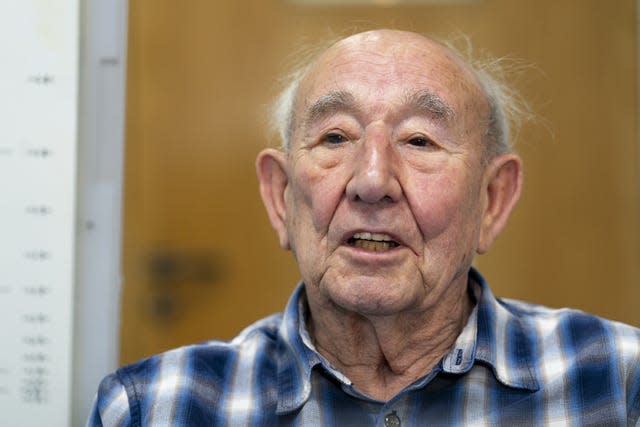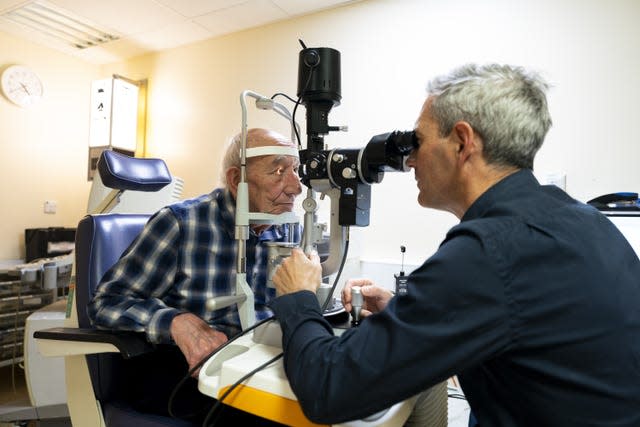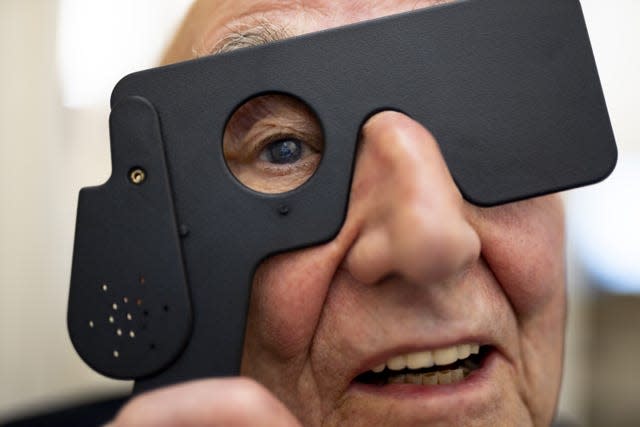The 91-year-old man made history by becoming the first patient in England to receive an artificial cornea.
Cecil Farley faced a year-long wait for sight-saving surgery after his human cornea transplant failed, but his surgeon offered him the chance to skip the queue by using an artificial cornea.
Health officials hope that one day new artificial corneas could reduce the need for human cornea donations.
Frimley Health NHS Foundation Trust consultant ophthalmologist Thomas Poole told the PA news agency that the use of artificial corneas was a “major advance in patient care”.
The new product replaces the inner part of the cornea.
Similar to a contact lens, it is surgically attached to the eye with a single stitch and placed in place with a gas bubble.
Mr Farley, known to his friends as John, said the transplant surgery allowed him to continue seeing his wife, Elizabeth, 83.

He had no vision in his right eye, but his vision has been slowly improving since the procedure was performed in February.
Mr Farley, from Chobham in Surrey, had eye problems for about 15 years.
Doctors from Frimley recommended the procedure, a type of corneal implant called endothelial keratoplasty, which involves removing the abnormal inner lining of the cornea and replacing it with an artificial cornea rather than a donated human cornea.
“After 63 years of marriage I can still see my wife, we can carry on as normal and live life to the fullest we can,” Mr Farley told PA.
“When your eyes work properly, it makes your life fuller; you don’t realize how debilitating it is until it happens to you.”
The retiree, who used to own a flooring company, said that he would like to do practical work such as repairing clocks when his eyesight is fully recovered, but for now he is content with “playing”.
“It’s made a huge difference to my vision. It was very blurry and I couldn’t make out a face. I can see better with it now, the brighter the light the better. It’s progressing slowly; they said it could take up to a year,” Mr Farley said.
The cornea is the transparent outer layer at the front of the eyeball.


When the cornea is damaged as a result of injury or disease, its transparency may decrease or its shape may change.
This can block light from reaching the retina at the back of the eye, causing the image transmitted to the brain to be distorted or unclear.
A corneal transplant may be performed to improve vision, relieve pain, and treat serious infection or damage.
Cornea transplants are usually made from deceased donors.
Mr Poole and his colleague Hanbin Lee have successfully administered artificial corneas to four patients in the past two months, with initial results showing an improvement in vision.
“This will be a huge advance in patient care and a great opportunity for some patients who cannot wait very long or have other conditions with their eyes,” Mr Poole said.
“We now have a very long waiting list for human corneas, which we have been using successfully for years. The problem is that if you have patients whose eyes are deteriorating, you can’t get human corneas for more than a year.
“There are risks to being on the waiting list due to an eye condition; Doing nothing also has risks, such as getting an infection.
“One of the beauties (of the artificial cornea) is that it is not human tissue, so the body does not try to reject it.
“Looking into the future, I think this could replace the human cornea in some corneal graft patients. Maybe in 10 or 20 years this could become the norm where we don’t need a human cornea and can just pull one out of the box.”


Mr Poole added: “I’ve just booked three people for this. All three have had failed transplants in the past and all three are facing a one-year waiting list. We can take it off the shelf. I can do this in the next few months instead of waiting a year.
“The three patients I listed today are examples of this; they will no longer need human corneas, which will take pressure off waiting lists.”
Speaking about Mr Farley’s case, Mr Poole said: “He had a failed corneal graft and his cornea, the clear window at the front of the eye, was cloudy and waterlogged.
“He had had multiple surgeries before and my concern was that we could use human cornea again for him, but the risk of failure was high… he was kind of starting to lose hope.
“John had this artificial cornea fitted in February and we can already see clinically that his cornea is much less swollen than before and its shape and clarity have improved. He says things are getting better every week.”
Mr Poole added: “I had argued with him very openly before and said to him: ‘Look, your bribe has failed, you’re back on the waiting list. Because you can see quite well in your other eye, you’re not a high priority on the waiting list and you may have to wait another year.’
“He’s in his 90s now and he said, ‘I can’t wait that long.’ Is there anything else?’ And this came to my mind: “I read a publication with very good reports about this artificial vaccine, and it really got me thinking, maybe we could use it for John.”
Professor Sir Stephen Powis, national medical director for NHS England, said: “The use of artificial corneal transplants is an exciting and innovative step forward in eye care, which has the potential to benefit many patients who need treatment to improve or restore their vision.
“It could provide an additional treatment option for those waiting for donated transplants, and it is heart-warming to hear that patients like Cecil are already benefiting from its use.”


According to the latest available figures, around 4,719 corneas were supplied to NHS Blood and Transplant Eye Banks in 2022/23 and 3,529 transplants were carried out.
In the past, some potential organ donors have stated that they are willing to donate their organs such as heart, liver and kidney, but prefer not to donate their corneas.
Kyle Bennett, deputy director of tissue and eye services at NHS Blood and Transplant, said: “We understand that people often attribute more emotion and symbolism to the eyes than to other parts of the body and therefore may be reluctant to accept cornea donation.
“But even if solid organ donation is not possible, accepting this type of donation means there can be light after darkness for thousands of people in need of corneal transplants.
“A single donor can help up to 10 people restore or improve their eyesight, allowing them to see their friends and family properly again.
“We are so grateful to all those who agreed to donate their corneas after their death, restoring or improving the eyesight of 3,259 people through corneal transplantation last year.”
The new artificial cornea, called EndoArt, was created by ophthalmological medical device company EyeYon Medical.
Only 200 have been implanted worldwide to date, including Mr Farley’s.
“EndoArt is the first artificial endothelial sheet that is a promising treatment for selected eyes with chronic corneal edema,” said Charles Holmes, the company’s chief commercial officer.
“EndoArt represents new hope as an alternative to human tissue for patients suffering from chronic corneal edema.”